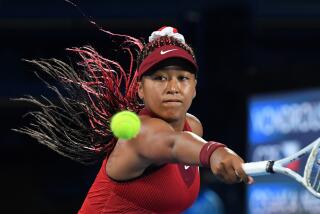Jaeger Ousted in Battle of What-Might-Have-Beens
- Share via
NEW YORK — y played an old-timers’ match Thursday on the Grandstand Court in the second round of the U.S. Open. Remember these names: Andrea Jaeger . . . Kathy Jordan?
Oh, yeah. The mind begins to reel in the years.
Flashback: Jaeger, relentlessly wearing down opponents with moonball rallies from the baseline, reaches the world ranking of No. 2 in 1981, advances to the French Open final in 1982 and reaches the final at Wimbledon in 1983.
Flashback II: Jordan, the feisty serve-and-volley player from King of Prussia, Pa., scrambles her way past Chris Evert Lloyd at Wimbledon in 1983 and into the top five by the spring of 1984.
Seems like eons ago.
Now, they’re just a couple of unseeded players, just two among the cast of hundreds at Flushing Meadow. Jordan beat Jaeger, 3-6, 6-2, 6-2, and hardly anybody was on hand to notice.
How did Jordan, four months shy of her 26th birthday, and Jaeger, who turned 20 in June, get where they are?
These are players too young to be entries in the whatever-happened-to file, too young for misty-eyed reminiscing about the good old days, too young to be trudging the comeback trail.
A Jaeger-Jordan match belongs in the U.S. Open quarterfinals. It shouldn’t happen on the third day of the tournament, billed as just another match, witnessed by a sparse and largely ambivalent audience.
But Jordan, recovering from a stress fracture in her foot, has slumped to 18th in the world rankings. And Jaeger, who took an eight-month sabbatical for assorted reasons, has played only nine matches in 1985.
Jaeger’s tale is a particularly somber one. Her rise took her nearly to the pinnacle of her profession. During her fall, she was throwing tantrums on the court and punching out victorious opponents.
Eventually, she bailed out. Jaeger cited injuries after a shoulder problem forced her to withdraw from the second round of last summer’s Olympic tennis demonstration.
Others speculated about tennis burnout.
“They blew up the whole burnout issue,” Jaeger said. “People started talking burnout, then I got hurt, and people kept talking burnout.”
Jaeger eyed a reporter.
“Say you didn’t have typewriters or computers and you had to do everything by hand,” she said. “Then, say you broke your right hand and couldn’t write. Wouldn’t you feel a little frustrated because you lost your job because you couldn’t write?
“Of course, it’s going to bother you. You liked writing, and all of a sudden you can’t do it. And you keep on trying, but it takes you three weeks to get something in instead of two. Or three days instead of one day.
“You think people are going to stop and wait for you? They’re not. Someone else is waiting for your job.
“For me, it’s just as frustrating. You can’t help it, but it’s there and it’s happened.”
Still, when the Women’s Tennis Assn. adopted new eligibility guidelines Wednesday as a way of coping with physical and mental burnout among young players, some were quick to label the measure the Andrea Jaeger Rule.
Jaeger said: “I think this stuff was put on me because I was young and I won. There are probably other kids out there now who are injured, but nobody cares. And did anybody care that my sister couldn’t play at Stanford (because of injuries)? Did they ask her if she was burned out?
“No. But that’s just the way it goes and that’s too bad.”
Jaeger has a point. Before she and Tracy Austin left the tour, there actually was some intrigue in the women’s division. Martina Navratilova or Lloyd could enter a tournament and not necessarily be guaranteed the winner’s check before the first serve.
But when Jaeger and Austin went down, the big four became the big two. And tennis promoters lost half of their pool of gate attractions.
Of course, people are going to ask questions.
At Jaeger’s postmatch press conference, someone asked about Austin.
“I saw her at a function for Tennis magazine,” Jaeger said. “She said she was 100% but she was waiting for ’86 or something like that. I said, ‘Why are you waiting?’ I’d love to say I’m 100%.
“Tracy’s different from me. She started so young and she was No. 1 for a while. Everything had to go her way. If she comes back and doesn’t do well in the beginning, if she loses a little at first, I don’t think she can accept it.
“I’m certain it’s a mental thing. If she’s 100% and not playing, it must be more mental.”
Austin has been off the circuit, excluding an occasional exhibition or aborted comeback try, for two years. When Jaeger’s layoff reached eight months, she decided she had to give it another try.
Jaeger said of Austin: “If she doesn’t start soon, I don’t think she’ll make it. If I would have waited two years, I wouldn’t have made it.
“This is an individual sport, and you have to be selfish. If she walked into the locker room, people would say hello but they wouldn’t care if she came back. Nobody cared when I came back. They want one less person on the computer.”
Jaeger’s comeback is still in the spinning-wheels stage. She has entered four tournaments in 1985--reaching the third round at Mahwah, N.J., and losing in the second in San Diego, the French Open and, now, the U.S. Open.
“Her movement is not as good as it was, and she’s not as consistent as she was,” Jordan said. “But she has improved since a few months ago.”
Jaeger knows there is room for much improvement. She cited the specific areas.
“My forehand, my backhand, my serve,” she said.
“It’s going to be hard. I can’t expect to all of a sudden do well, and that’s it. People just don’t bend over and lose to you.”
Once, that almost seemed the routine for Jaeger. But that was in the old days, when Jaeger was young.
Like 17.
More to Read
Go beyond the scoreboard
Get the latest on L.A.'s teams in the daily Sports Report newsletter.
You may occasionally receive promotional content from the Los Angeles Times.










